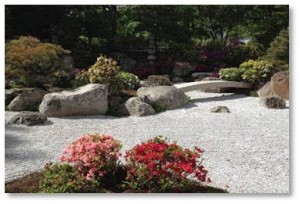This is the first in a series of posts about hidden or largely unknown places in Boston that ordinary folks can visit. Some are outside and some are inside and some bring the outdoors in. They are little jewels that even many residents don’t know about but are definitely worth a visit. We’ll start with a celestial spot.
The Heart of Heaven
 “Tenshin-en,” the “Garden of the Heart of Heaven,” occupies a small but beautiful space behind Boston’s Museum of Fine Arts. Tenshin-en is a karesansui, a contemplative garden that reinterprets the art form of Japan’s 15th-century temple gardens. It was designed by the late Professor Kinsaku Nakane of Kyoto and named in honor Kakuzō Okakura, who was known in Japan as Okakura Tenshin. Tenshin-san worked at @mfaboston as the curator of the museum’s vast collection of Asiatic art from 1904 until his death in 1913. The garden was dedicated in 1988 and re-opened this year after 12 months of extensive work that included replanting of and pruning.
“Tenshin-en,” the “Garden of the Heart of Heaven,” occupies a small but beautiful space behind Boston’s Museum of Fine Arts. Tenshin-en is a karesansui, a contemplative garden that reinterprets the art form of Japan’s 15th-century temple gardens. It was designed by the late Professor Kinsaku Nakane of Kyoto and named in honor Kakuzō Okakura, who was known in Japan as Okakura Tenshin. Tenshin-san worked at @mfaboston as the curator of the museum’s vast collection of Asiatic art from 1904 until his death in 1913. The garden was dedicated in 1988 and re-opened this year after 12 months of extensive work that included replanting of and pruning.
A Hidden Oasis
I have made this the first hidden gem in the series because you can’t see it from the street or enter it from the museum. Museum Director Malcolm Rogers says that Tenshin-en should serve as “a serene oasis in the heart of the museum, where visitors can withdraw from its bustling labyrinth of hallways to refresh themselves in its calm beauty.” Yet you can see it from only one second-floor gallery that leads from the Art of Europe into the Linde Wing for Contemporary Art. And even there, you have to peer carefully around sculptures in the window bays to catch a glimpse of Tenshin-en.
There is no “viewing window,” as you might find in Japan, nor is any information about the garden placed there. No directions to it are provided from inside the museum. You will learn more about Tenshin-en in this post than you will see anywhere in the Museum of Fine Arts. Hidden, indeed.
Once you know where it is, however, the Garden of the Heart of Heaven is easily entered from the sidewalk along the Fenway. There is no admission fee and you can just walk right in.
The Karesansui Design
Professor Nakane described his karesansui design this way:
“The goal of a karesansui garden is to suggest magnificent scenes from nature by forming the shapes of various landscape elements such as waterfalls, mountains, islands and ocean … thus the garden expresses the vastness of nature in miniature, within a strictly limited space.”
Tenshin-en’s very limited space is a world of its own. When inside the traditional mud-and-twig wall, you would never know that a well-traveled road is just beyond it. A path borders a “stream” of raked crushed granite and leads to viewing benches. The 10,000 square-foot garden includes:
 More than 200 stones
More than 200 stones- A dry waterfall (takiguchi)
- Tall stones representing the mythic Mount Sumeru
- Tall stones representing the Mystic Isles of the Immortals, the Tortoise Island (kamejima), and the Crane Island (tsurujima)
- More than 70 species of plants—1,750 specimens from America and Japan
- Three arched granite bridges
- A stone pagoda
- A stone temple lamp
- A fountain for hand washing
That’s a lot, yet the garden is so harmonious, so beautifully arranged, it doesn’t seem at all crowded. The visitor experiences it like a three-dimensional painting that merges the Japanese and American cultures.
Tenshin-en is best seen in the spring when the azaleas bloom but it is beautiful at any time of year. In the fall the cherry trees and Japanese maples add color to the dark green pines and winter turns it into a study in black and white.
Directions to Tenshin-en
It’s easy to find Tenshi-en. If you live locally, just stroll west along the Fenway, past the MFA’s rear entrance and turn left. There you will find the roofed gate that was built in Kyoto and reconstructed in Boston by Japanese carpenters.
Tenshin-en is a hidden gem that’s just waiting for your visit. Follow the path, sit, and contemplate the garden or meditate. When I was there two weeks ago, a young man was meditating on a bench—an activity which my rambunctious granddaughter unfortunately interrupted. You will probably have a more contemplative experience.
More Information on Tenshin-en
For more information on and pictures of Tenshin-en, follow these links:
- Japanese Garden, Tenshin-en – Museum of Fine Arts website
- Japanese Garden, Tenshin-en – Museum of Fine Arts video
- “These Japanese Gardens Turn Nature Into Man-Made Paradises” by Lee Lawrence in The Wall Street Journal
- “The Tenshin-en at Boston’s Museum of Fine Arts” — NPR


